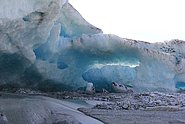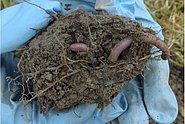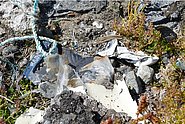Microbial communities in the soil, consisting of bacteria, fungi and protists, are crucial to the functioning of ecosystems. We research how this biodiversity is altered by climate change, changes in land use and intensive cultivation, for example in the Arctic and in the permafrost of the Alps, and in Swiss forests.
Contents ¶
Microbial diversity ¶
Biodiversity is crucial to the functioning of global ecosystems. Microbial life contains the greatest diversity of organisms and is found in every imaginable habitat, from the human body to the deepest oceans. The diversity of microorganisms in the soil is vast and still largely unknown. It is only possible to identify many of these species and differentiate them from one other thanks to genetic methods allowing the genotype of the organisms to be analysed.
It is not just the diversity of species in the soil that is crucial, but the functional diversity, i.e. how many different functions these species perform. Microbial soil processes play a key role in global and ecological material cycles. Units within biotic communities, either acting autonomously or interacting with each other, have a major impact on the global nutrient cycle, the decomposition of organic matter and toxic substances, and climate evolution. Without microorganisms, there would be no life on earth.
Our changing environment ¶
Global changes, such as global warming, environmental pollution and intensive cultivation, exert powerful forces on terrestrial and aquatic ecosystems. These forces also affect soil biodiversity and bring about lasting changes. Negative changes range from the loss of essential ecosystem functions to the invasion of pathogenic organisms. Given the crucial role of microbial diversity, it stands to reason that the diversity, activity and functions of these communities are regarded as strong indicators of these types of environmental change. Diverse and functionally sound microbial communities are therefore essential for the preservation and sustainable utilisation of global ecosystems. There continues to be major uncertainties and a significant need for research in this regard. As such, the priority is to gain a better understanding of the role of microorganisms in biogeochemical material cycles.
In the research group «Rhizosphere Processes», we examine how, for instance, soil microbes in the Arctic or the Alps react to climate change as part of international collaborative projects. We are continuing to research the astonishingly rich microbial life in the permafrost (permanently frozen soil). It is still unclear how the microorganisms that are adapted to the cold survive in the permafrost, and how cells are able to metabolise and even reproduce. Other research focuses on man-made influences on soil organisms, such as soil compaction by heavy forestry machinery or mercury discharge into the soil.
Contact ¶
Publications ¶
Cuartero J., Briones M.J.I., Rast B.M., Stierli B., Maurer-Troxler C., Hug A.S., … Frey B. (2025) Earthworm and enchytraeid indicator taxa of different land-use types identified using soil DNA metabarcoding. Appl. Soil Ecol. 206, 105891 (16 pp.). doi:10.1016/j.apsoil.2025.105891 Institutional Repository DORA
Jian Z., Zeng L., Lei L., Frey B., Liu C., Shen Y., … Li M.H. (2025) Fungi stimulate organic phosphorus fraction transformation in subtropical masson pine plantation soils after nine years of thinning and understory removal. Ecol. Process. 14(1), 23 (13 pp.). doi:10.1186/s13717-025-00586-0 Institutional Repository DORA
Anthony M.A., Tedersoo L., De Vos B., Croisé L., Meesenburg H., Wagner M., … Averill C. (2024) Fungal community composition predicts forest carbon storage at a continental scale. Nat. Commun. 15, 2385 (13 pp.). doi:10.1038/s41467-024-46792-w Institutional Repository DORA
Cuartero J., Frey B., Eder R., Brunner I. (2024) More than a decade of irrigation alters soil nematode communities in a drought-prone Scots pine forest. Appl. Soil Ecol. 203, 105621 (10 pp.). doi:10.1016/j.apsoil.2024.105621 Institutional Repository DORA
Cuartero J., Querejeta J.I., Prieto I., Frey B., Alguacil M.M. (2024) Warming and rainfall reduction alter soil microbial diversity and co-occurrence networks and enhance pathogenic fungi in dryland soils. Sci. Total Environ. 949, 175006 (15 pp.). doi:10.1016/j.scitotenv.2024.175006 Institutional Repository DORA










